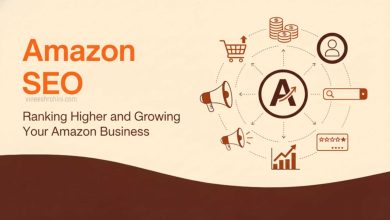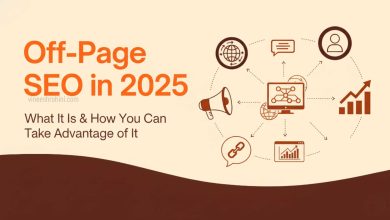Shopify SEO: Step-by-Step Comprehensive Guide 2025
Shopify SEO : In the fast-evolving world of e-commerce, visibility is everything. With thousands of online stores competing for attention, optimizing your Shopify store for search engines is no longer optional—it’s essential. Shopify SEO, when done right, can significantly improve your organic traffic, increase conversions, and drive consistent revenue without relying solely on paid ads.
Table of Contents
Whether you’re launching a new Shopify store or looking to boost an existing one, this ultimate step-by-step comprehensive guide for 2025 will provide you with the most up-to-date techniques, high-ranking strategies, and advanced SEO insights to dominate G and other search engines.
Understanding Shopify SEO Basics

Shopify SEO refers to the process of optimizing your Shopify website to rank higher in search engine results pages (SERPs). While Shopify is known for its user-friendly interface and powerful ecommerce tools, it comes with certain SEO limitations that require specific strategies to overcome. The platform handles some on-page SEO elements automatically, but for long-term success, you must manually optimize key elements like metadata, site structure, content, and technical performance.
Also Read : How to Build an Ecommerce Website Using Shopify
High-reaching keyword focus: Shopify SEO 2025, Shopify search engine optimization, best SEO practices for Shopify, how to rank Shopify store on G
Conducting Comprehensive Keyword Research
Before you start optimizing your Shopify store, identify the right keywords. Keyword research lays the foundation of successful SEO.
- Use tools like G Keyword Planner, SEMrush, Ahrefs, or Ubersuggest to find keywords related to your niche
- Focus on transactional keywords like “buy men’s leather shoes online” and long-tail keywords like “affordable women’s yoga pants under ₹1000”
- Analyze competitors’ keywords using tools like SpyFu or Ahrefs Site Explorer
- Consider voice search queries in 2025 such as “where can I buy eco-friendly sneakers near me?”
Create a keyword list for each collection, product page, blog, and static page of your site.
High-reaching keyword focus: Shopify keyword research, Shopify SEO tools, long-tail keywords for Shopify, voice search optimization Shopify
Optimizing Shopify Product Pages for SEO
Your product pages are where conversions happen, so they must be fully optimized for SEO.
- Write unique, keyword-rich product titles that reflect search intent
- Craft compelling meta descriptions that include benefits and call-to-actions
- Use H1 and H2 headings to structure product information clearly
- Add alt text to all images using keywords naturally
- Implement structured data markup (JSON-LD) for product schema so G can show rich snippets like price, ratings, and availability
- Create SEO-friendly product URLs (e.g., yourstore.com/products/organic-green-tea) by avoiding auto-generated gibberish
Also, avoid duplicate content by writing original descriptions instead of using manufacturer-provided text.
High-reaching keyword focus: product page SEO Shopify, optimize Shopify product descriptions, structured data Shopify SEO
Creating a Clean and Scalable URL Structure
Shopify automatically generates URLs, but they often include redundant folders like /collections/ and /products/. While you can’t remove these completely, you can:
- Ensure URLs are short, descriptive, and include your target keywords
- Avoid URL changes after publication to prevent broken links
- Use hyphens instead of underscores for better readability
- Redirect old URLs using 301 redirects to preserve link equity
Keep internal links consistent to help search engines crawl and index your site properly.
High-reaching keyword focus: Shopify URL structure best practices, optimize Shopify URLs for SEO, Shopify SEO-friendly URLs
Enhancing Shopify Site Speed and Mobile Performance

Page speed and mobile usability are critical ranking factors in 2025. A slow-loading store loses both search rankings and customers.
- Choose a lightweight and mobile-optimized Shopify theme
- Compress images using WebP format and lazy-load below-the-fold images
- Minify CSS, JavaScript, and HTML files
- Use fast, reliable Shopify hosting and enable HTTP/3 if available
- Remove unused Shopify apps that add unnecessary scripts
- Use Shopify’s built-in speed analyzer or G PageSpeed Insights to diagnose performance issues
Mobile-first design ensures your site performs well across all devices, especially smartphones.
High-reaching keyword focus: Shopify mobile speed optimization, Shopify site speed SEO, mobile-friendly Shopify themes
Mastering Shopify Collection Pages for SEO
Collection pages (categories) are important for organizing products and improving UX. To optimize them:
- Include a keyword-rich title and description using H1 and H2 tags
- Write a unique, 200–300 word description for SEO below the fold
- Add internal links to popular products and related collections
- Avoid thin content pages with fewer than 3 products
- Add a blog snippet or user-generated content for dynamic content
Properly optimized collection pages improve crawlability and keyword targeting.
High-reaching keyword focus: Shopify collection page SEO, Shopify category optimization, improve collection ranking Shopify
Implementing On-Page SEO for Static Pages
Don’t overlook static pages like the homepage, About Us, Contact, FAQs, and Policy pages. These pages can also rank for branded and long-tail keywords.
- Use proper heading hierarchy (H1, H2, H3) across all pages
- Optimize page titles and meta descriptions manually for each page
- Add schema markup for contact information and FAQs
- Include internal links pointing to relevant products and collections
These static pages build trust and help with brand-related search queries.
High-reaching keyword focus: homepage SEO Shopify, About Us page optimization Shopify, SEO for FAQ page Shopify
Building a Strategic Internal Linking Structure
Internal links help distribute authority across your site and improve indexation.
- Link related products within product descriptions
- Use breadcrumbs for easy navigation and context
- Link blog posts to collections and vice versa
- Add a “Popular Products” or “You May Also Like” section with relevant links
Anchor text should be descriptive and include target keywords without overstuffing.
High-reaching keyword focus: Shopify internal linking strategy, improve Shopify crawlability, link structure Shopify SEO
Creating SEO-Optimized Blog Content

Content marketing via blogging remains one of the most powerful Shopify SEO strategies.
- Start a blog on Shopify and post regularly with keyword-rich topics
- Focus on evergreen content like “How to choose the best [product]” or “Top 10 [product] for summer 2025”
- Use LSI (Latent Semantic Indexing) keywords to support your primary keyword
- Add internal links to products and collections from each blog
- Promote content on social media and via backlinks to improve domain authority
A well-structured blog drives traffic and improves topical relevance in your niche.
High-reaching keyword focus: Shopify blogging for SEO, Shopify blog content strategy, ecommerce blog SEO tips
Fixing Duplicate Content and Canonical Issues
Shopify sometimes creates duplicate content through tags, filters, and product variants.
- Set canonical tags manually to inform search engines about the preferred version
- Use Shopify’s built-in canonical system or adjust theme.liquid template if needed
- Avoid using tags that create duplicate content (e.g., multiple tag pages showing same products)
- Use 301 redirects to eliminate unnecessary page versions
Duplicate content can dilute rankings and confuse search engines.
High-reaching keyword focus: fix duplicate content Shopify, Shopify canonical tag SEO, remove duplicate URLs Shopify
Building Quality Backlinks for Shopify SEO
Off-page SEO, especially backlinks, remains a top-ranking factor in 2025.
- Reach out to industry blogs and influencers for guest posts or product reviews
- Submit your store to high-quality directories and niche sites
- Use broken link building by finding dead links and offering your content as a replacement
- Get featured in gift guides, roundups, and press mentions
- Engage in PR activities like product launches, giveaways, and collaborations
Focus on acquiring links from relevant, authoritative websites in your niche.
High-reaching keyword focus: Shopify backlink strategy, build ecommerce backlinks, link building for Shopify store
Leveraging Technical SEO for Shopify
Technical SEO ensures your Shopify store is easy for search engines to crawl, index, and understand.
- Generate and submit an updated XML sitemap through Shopify
- Create a custom robots.txt file to block irrelevant or duplicate pages
- Set up G Search Console and Bing Webmaster Tools for performance tracking
- Implement hreflang tags if you operate in multiple countries or languages
- Monitor and fix crawl errors and broken links regularly
An optimized technical foundation enhances all other SEO efforts.
High-reaching keyword focus: Shopify technical SEO checklist, XML sitemap Shopify SEO, robots.txt optimization Shopify
Optimizing for Shopify Core Web Vitals
Core Web Vitals have become a major SEO ranking factor and directly affect user experience.
- Largest Contentful Paint (LCP): Optimize image sizes and server response times
- First Input Delay (FID): Minimize third-party scripts and heavy JavaScript
- Cumulative Layout Shift (CLS): Reserve space for ads, banners, and fonts
Shopify stores must pass these metrics to remain competitive in G’s mobile-first index.
High-reaching keyword focus: Core Web Vitals Shopify, improve LCP FID CLS Shopify, user experience SEO Shopify
Tracking and Monitoring Shopify SEO Performance
You can’t improve what you don’t measure. Use analytics and reporting tools to monitor progress.
- G Analytics 4 for tracking traffic, conversions, and bounce rates
- G Search Console for keyword impressions, clicks, and technical issues
- SEO audit tools like Ahrefs, Moz, Screaming Frog for comprehensive site health checks
- Rank tracking tools like Serpstat, AccuRanker, or SE Ranking to monitor keyword positions
Regular analysis helps you adapt and refine your SEO strategies.
High-reaching keyword focus: track Shopify SEO performance, best SEO tools for Shopify, rank monitoring Shopify
Staying Ahead with Shopify SEO in 2025
Ecommerce SEO is always evolving. Staying updated with trends and algorithm updates is crucial.
- Keep up with G’s algorithm changes like the Helpful Content Update or SpamBrain
- Invest in video content and optimize for YouTube search if your products support it
- Consider AI-generated descriptions with human oversight for speed and accuracy
- Experiment with voice and image search optimization
Shopify’s ecosystem constantly adds new SEO features, so staying agile ensures long-term visibility.
High-reaching keyword focus: latest Shopify SEO trends 2025, AI SEO Shopify, voice search optimization ecommerce
Conclusion
Mastering Shopify SEO in 2025 requires a multi-faceted approach that combines technical excellence, strategic content creation, powerful link building, and ongoing optimization. With this comprehensive guide, you now have the roadmap to significantly increase your Shopify store’s visibility, traffic, and conversions in the competitive ecommerce landscape.
Buy Now : 100+ Shopify Premium Themes
Whether you’re a beginner or a seasoned marketer, the key to SEO success lies in consistent effort, data-driven decisions, and staying updated with best practices. As more shoppers search from mobile and voice-enabled devices, the stores that focus on fast, relevant, and optimized experiences will win. Start implementing these Shopify SEO strategies today and turn your online store into a top-ranking sales machine.
Disclaimer: The information in this guide is based on current SEO practices as of 2025. SEO trends and G algorithm updates may change, so always keep learning and testing.



